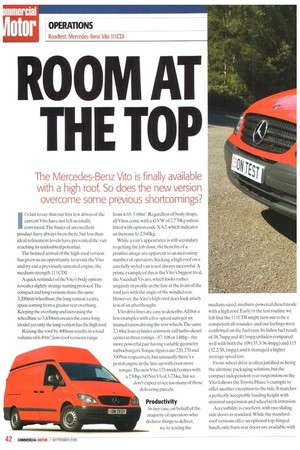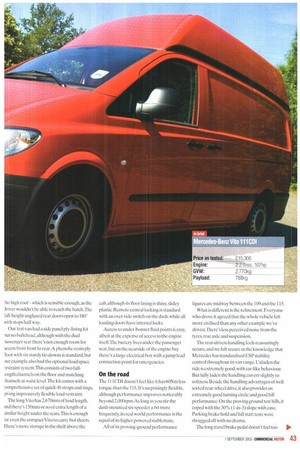ROOM AT THE TOP
Page 42

Page 43

Page 44

If you've noticed an error in this article please click here to report it so we can fix it.
The Mercedes-Benz Vito is finally available with a high roof. So does the new version overcome some previous shortcomings?
It's fair to say that our first few drives of the current Vito have not left us totally convinced.The basics of an excellent product have always been there, but less than ideal refinement levels have prevented the van reaching its undoubted potential.
The belated arrival of the high-roof version has given us an opportunity to revisit the Vito and try out a previously untested engine, the medium strength 1 1 I CD1.
A quick reminder of the Vito's body options reveals a slightly strange naming protocol.The compact and long versions share the same 3,200mm wheelbase; the long version's extra space coming from a greater rear overhang. Keeping the overhang and increasing the wheelbase to 3,430mm creates the extra-long model,yet only the long version has the high roof Raising the roof by 400mm results in a load volume of 6.49m3; low-roof versions range from 4.655.68m3. Regardless of body shape. all Vitas come with a GVW of 2,770kg unless fitted with option code X A2, which indicates an increase to 2,940kg.
While a van's appearance is still secondary to getting the job done, the benefits of a positive image are apparent to an increasing number of operators. Sticking a high roof on a carefully styled van is not always successful. A prime example of this is the Vito's biggest rival, the Vauxhall Vivaro, which looks rather ungainly in profile as the line at the front of the roof jars with the angle of the windscreen. However, the Vito's high roof does look much less of an afterthought.
Vito driveli nes are easy to describe. All bar a few examples with a live-speed auto get six manual ratios driving the rear wheels.The same 2.148cc four-cylinder common-rail turbo-diesel comes in three ratings —87, 108 or 148hp—the more powerful pair having variable geometry turbochargers.Torque figures are 220,270 and 330Nm respectively, but unusually there's a petrol engine in the line-up with even more torque. The new Vito 123 model comes with a 230hp,345Nm V6 of 3,724cc, but we don't expect to see too many of those delivering parcels.
Productivity
In any case, on behalf of the majority of operators who do have things to deliver, we're testing the medium-sized, medium-powered diesel mode with a high roof. Early in the test routine we felt that the 111CDI might turn out to be a competent all-rounder, and our feelings were confirmed on the fuel runs. Its laden fuel result of 38.7mpg and 40.1mpg unladen compared well with both the 109 (35.3/36.4mpg) and 115 (32.2/38.1mpg); and it managed a higher average speed too.
Front-wheel drive is often justified as being the ultimate packaging solution, but the compact independent rear suspension on the Vito follows the Toyota Hiace's example to offer another exception to the rule. It matches a perfectly acceptable loading height with minimal suspension and wheel arch intrusion.
Accessibility is excellent, with two sliding side doors as standard.While the standardroof versions offer an optional top-hinged hatch, only barn rear doors are available with the high roof — which is sensible enough, as the driver wouldn't be able to reach the hatch.The full-height unglazed rear doors open to 180' ■ vith stops halfway.
Our test van had a side panel ply-lining kit put no bulkhead,although with the dual Dassenger seat there's not enough room for iccess from front to rear. A phenolic-resin ply loor with six sturdy tie-downs is standard, hut 31.1 r example also had the optional load space restraint system:This consists of two fullength channels on the floor and matching :flannels at waist level .The kit comes with a :omprehensive set of quick-fit straps and rings, ;iving impressively flexible load restraint.
The long Vito has 2,670mm of load length. Ind there's 150mm or so of extra length of a ;imilar height under the seats. This is enough :or even the compact Vito to carry 8x4 sheets. There's more storage in the shelf above the cab, although its floor lining is shiny, slidey plastic. Remote central locking is standard with an over-ride switch on the dash. while all loading doors have internal locks.
Access to under-bonnet fluid points is easy, albeit at the expense of access to the engine itself, The battery lives under the passenger seat, but on the nearside of the engine bay there's a large electrical box with a jump lead connection point for emergencies.
On the road The 111CDI doesn't feel like it has 60Nm less torque than the 115. It's surprisingly flexible, although performance improves noticeably beyond 2,0(X)rpm. As long as you stir the dash-mounted six-speeder a bit more frequently, its real world performance is the equal of its higher powered stablemate.
All of its proving-ground performance figures are midway between the 109 and the 115.
What is different is the refinement. Everyone who drove it agreed that the whole vehicle felt more civilised than any other example we've driven. There's less perceived noise from the tyres. rear axle and suspension.
The rear-driven handling feels reassuringly secure, and we felt secure in the knowledge that Mercedes has standardised ESP stability control throughout its van range. Unladen the ride is extremely good.with car-like behaviour. But fully laden the handling can err slightly to softness. Beside the handling advantages of well sorted rear-wheel drive, it also provides an extremely good turning circle and good hill performance. On the proving ground test hills, it coped with the 30% (1-in-3) slope with ease. Parking brake hold and hill start tests were shrugged off with no drama.
The long travel brake pedal doesn't feel too reassuring, but the brakes work extremely well in both normal and emergency situations. Our biggest remaining gripe with the Vito is the ridiculous American-style foot-operated parking brake. While fine with an automatic gearbox. expecting your left leg to simultaneously control parking brake and clutch is one task too many.To make matters worse, releasing it results in a resounding clang. For goodness' sake, M-B, at least specify the Hill Hold that's standard on the Actros— the Vito needs it more.
Visibility is generally good. although heavy A-pillars restrict visibility and their small triangular windows are best treated as styling features.The windscreen is a long way from the driver, slightly compromising the ability to see where the front is in a tight spot, Large wipers carry washer jets and are of the 'clap hand' type, reaching right up to both edges of the screen!The non-remote adjustable mirrors have no blind-spot lenses but are decently sized and do not obstruct the forward view.
Cab comfort There's no problem getting comfortable thanks to a full range of seat and steering column adjustabilityThe dual passenger seat comes with headrests and three-point inertia belts for all, height adjustable on the outer seats.
The cab interior is almost completely trimmed, apart from the painted steel of the rear door frame uprights It's mostly decentlooking plastic. dark grey on the top half and lighter grey below. Mid-grey seats have a colourful pattern.
The driving posi Lion puts you behind the optional multi-function steering wheel, which controls audio, trip computer and, when fitted, mobile phone functions The audio is an RDS radio/single-disc CD player, which defeated us when it came to activating traffic news (recourse to the manual revealed that you have to hold down the mute button).
The instrument panel houses the large l SO° speedometer which reads only in mph— km/h is shown on a digital display unit.To its left is a small 4,500rpm rev counter with the fuel gauge on the right.Time, distance, fuel consumption, time-to-next-service, audio and systems checks are monitored by the trip computer.
The single multi-function stalk on the left of the steering column controls lights wipers and the smart indicators Minor switches either side of the central hazard button include ASR traction control override, load space lighting and door locking. Electric window switches are on the door panels The ignition key is the bladeless infra-red type, and many controls appear identical to the C-class car but some, such as the park brake ratchet and steering wheel control buttons feel heavier duty and less refined in operation.
Cab storage is excellent,with large door bins, a glove box whose lid folds horizontally IA reveal cup recesses for stationary use, a tray on top of the central dash and smaller bins.The tool storage box accessed through the driver's step well has room for odds and ends includiN the restraint kit.To the left of the gear lever is the small smokers' compendium combined with a slide-out cup or can holder. •




































































































































































































